You are not currently logged in. Please create an account or log in to view the full course.
Chekhov: Life and Writing
- About
- Transcript
- Cite
Chekhov: Uncle Vanya
In this course, Professor Carol Apollonio (Duke University) explores Anton Chekhov’s Uncle Vanya. In the first lecture, we think about the figure of Anton Chekhov himself, his early life, his early writing, his travels round Russia, his health problems, and the great prose and dramatic works that he produced in the 1890s and 1900s. After that, in the second lecture, we think about the historical context in which Chekhov was writing Uncle Vanya – Russia of the 1890s – focusing in particular on the class hierarchy in Russia, the sense in which the 1890s were the twilight years of Imperial Russia, and the slow decay of the aristocratic way of life in the second half of the 19th century. In the third lecture, we think about how Chekhov constructs his plots, focusing in particular on the importance of the characters that *don’t* appear, the actions that *don’t* happen, the things that *aren’t* said, before turning in the fourth lecture to think about what names mean in Uncle Vanya. In the fifth lecture, we think about the extent to which the play has a ‘main character’ before turning in the sixth and final lecture to a potential allegorical reading of the play: a clash between the value of hard work (Astrov, Sonya, Vanya) and the values of aesthetics, art and beauty (Elena).
Chekhov: Life and Writing
In this lecture, we think about the figure of Anton Chekhov himself – his life and writing – focusing in particular on: (i) Chekhov’s status as one of the most well-known Russian writers, alongside Fyodor Dostoevsky (1821-81) and Leo Tolstoy (1828-1910); (ii) Chekhov’s early life: his early life in Taganrog; his family’s move to Moscow, leaving Chekhov behind, his own move to Moscow to study medicine; he earliest writings; and the first signs of tuberculosis; (iii) his decision to travel to Sakhalin Island in the Russian Far East in 1890, his work with the prisoners there, and the publication of his findings in Sakhalin Island (1893-94); (iv) his prose output in the 1890s, including ‘Ward No. 6’, ‘The Black Monk’, ‘My Life’ and ‘Three Years’; (v) his declining health and his move first to Nice (1897) and then to Yalta (1898); (vi) his work with the Moscow Art Theatre, including successful productions of The Seagull (1898), Uncle Vanya (1899), Three Sisters (1901) and The Cherry Orchard (1904); (vii) his marriage to the actress Olga Knipper; and (viii) the extent to which Chekhov was not at all like his male protagonists, as was previously thought, but fun-loving, socially active and gregarious.
Cite this Lecture
APA style
Apollonio, C. (2024, March 15). Chekhov: Uncle Vanya - Chekhov: Life and Writing [Video]. MASSOLIT. https://massolit.io/courses/chekhov-uncle-vanya
MLA style
Apollonio, C. "Chekhov: Uncle Vanya – Chekhov: Life and Writing." MASSOLIT, uploaded by MASSOLIT, 15 Mar 2024, https://massolit.io/courses/chekhov-uncle-vanya

